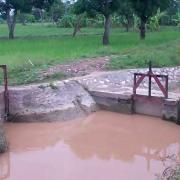- English
- Français
- Haitian Creole
CCISR, St Raphael
Categories:
 A community which has successfully implemented an extensive irrigation system with a partner, that is now managed by a local organisation and has revitilized agricultural production in the area.
A community which has successfully implemented an extensive irrigation system with a partner, that is now managed by a local organisation and has revitilized agricultural production in the area.
S t Raphael is a commune which is in the southern part of the North Department, a cross-roads between Cap Haitian, St Michel (in Artibonite), and Port au Prince. It one of the newest and largest public markets in the region, and is a hub for trade (particularly in rice and vegetables). This is because of an immense irrigation scheme that was installed in 1952 (called Nan Sipa), which supplies over 3,000 farmers with water for vegetable production (in the dry season) and rice production (in the rainy season).
t Raphael is a commune which is in the southern part of the North Department, a cross-roads between Cap Haitian, St Michel (in Artibonite), and Port au Prince. It one of the newest and largest public markets in the region, and is a hub for trade (particularly in rice and vegetables). This is because of an immense irrigation scheme that was installed in 1952 (called Nan Sipa), which supplies over 3,000 farmers with water for vegetable production (in the dry season) and rice production (in the rainy season).
 t Raphael is a commune which is in the southern part of the North Department, a cross-roads between Cap Haitian, St Michel (in Artibonite), and Port au Prince. It one of the newest and largest public markets in the region, and is a hub for trade (particularly in rice and vegetables). This is because of an immense irrigation scheme that was installed in 1952 (called Nan Sipa), which supplies over 3,000 farmers with water for vegetable production (in the dry season) and rice production (in the rainy season).
t Raphael is a commune which is in the southern part of the North Department, a cross-roads between Cap Haitian, St Michel (in Artibonite), and Port au Prince. It one of the newest and largest public markets in the region, and is a hub for trade (particularly in rice and vegetables). This is because of an immense irrigation scheme that was installed in 1952 (called Nan Sipa), which supplies over 3,000 farmers with water for vegetable production (in the dry season) and rice production (in the rainy season).In 1991, the Irrigation Block Commitee system was formed to allow the farmers in Nan Sipa to have more control over the resources needed to maintain the canal. The irrigation system comes from the River Bouyara, where it is captured and funneled into a central canal (which is 15.7 km long), which then empties into 19 secondary canals. Each secondary canal is divided into 3 tertiary canals, and each of those tertiary canals has 3 representatives of the farmers who use that water that serve on the 9-person committee for each block (a block is all the land supplied by a secondary canal). Each of the 19 committees sends 1 
representatives to the central committee, and this is how the system is managed.

representatives to the central committee, and this is how the system is managed.
The committees collect contributions from the farmers every year (800 gourdes per hectare) so that they have funds to maintain the system and fix it if there are problems. There is also a surveillance committee (which is separate from the central committee) which is responsible for overseeing the expeditures that the committee makes and ensuring they are well-spent. There is also a small field team which regularly walks the perimeter of the irrigated fields to keep an eye on the system overall, and they are given a small fee. In general, when there are problems, the farmers who are affected call konbit to make the system work. When there is a conflict among
the farmers, the committee is supposed to mediate, and if it is too difficult to mediate, they bring it to the local authorities and the police. This system has been able to maintain the canals for the past 2 decades; 3,000 farmers have land irrigated by the system.
Download full report (in english):
GPS coordinates:
Primary contact:
Poleon Beauvoir, 37098369
Anglais
Success gradient:
Commune:
St Raphael
Partners:
Agro-Action Allemande
- Identifiez-vous pour poster des commentaires
- Haitian Creole